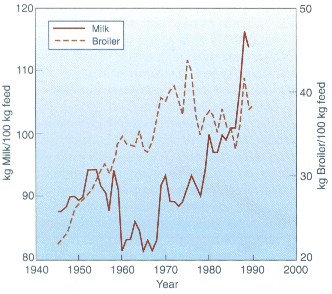




Next: Changing species
Up: Can Smarter Farming Spare
Previous: A ceiling on what
Although crops comprise primary production and
although eating crops rather than feeding them may
spare much land for Nature, a middle route is feeding
a crop to an animal more efficiently. In 365 days
recently, Tullando Royalty Maxima produced nearly
27 t of milk and 760 kg of protein (The Dairyman,
1993[dai93]). For a question about land, however, one must
switch from quantity and think of efficiency of converting
feed into milk or meat. Figure 7.4.1 shows the
production of an average American broiler chicken
or cow in weight of feed per weight of milk or poultry.
The feed to produce broiler meat
fell sharply from
1945 to 1970 but has remained about 2.5 units of feed
per unit of meat. About 1960, feed per cow rose faster
than milk per cow, depressing milk per feed (Figure 7.4.1).
Since 1970, however, farmers have been
getting more milk per feed. Showing that the improvement
was not mere dilution, the concentration
of fat in the milk stayed steady as the quantity grew.
Farmers, cows, and broilers show that more animal
product can be produced from each unit of feed.
 Figure 7.4.1. The course of the ratios of milk and broiler meat
produced in the United States to feed, as the
equivalent of corn. The ratios are weight of product
produced per 100 weight of feed (U.S. Department
of Agriculture, various years). The feed consumed
per head and per unit of production is expressed in
equivalent feeding value of corn. See, e.g., Table 76
of the 1992 Statistics. [USDa]
Figure 7.4.1. The course of the ratios of milk and broiler meat
produced in the United States to feed, as the
equivalent of corn. The ratios are weight of product
produced per 100 weight of feed (U.S. Department
of Agriculture, various years). The feed consumed
per head and per unit of production is expressed in
equivalent feeding value of corn. See, e.g., Table 76
of the 1992 Statistics. [USDa]
Yasuko Kitajima
Thu Jun 19 16:20:56 PDT 1997
 Figure 7.4.1. The course of the ratios of milk and broiler meat
produced in the United States to feed, as the
equivalent of corn. The ratios are weight of product
produced per 100 weight of feed (U.S. Department
of Agriculture, various years). The feed consumed
per head and per unit of production is expressed in
equivalent feeding value of corn. See, e.g., Table 76
of the 1992 Statistics. [USDa]
Figure 7.4.1. The course of the ratios of milk and broiler meat
produced in the United States to feed, as the
equivalent of corn. The ratios are weight of product
produced per 100 weight of feed (U.S. Department
of Agriculture, various years). The feed consumed
per head and per unit of production is expressed in
equivalent feeding value of corn. See, e.g., Table 76
of the 1992 Statistics. [USDa]